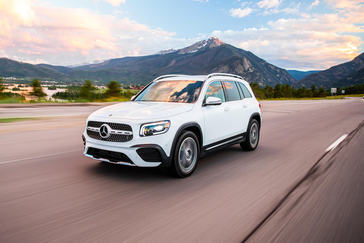GLB Summer Testing

Ever since the invention of the automobile by Carl Benz and Gottlieb Daimler, Mercedes-Benz has continued the tradition of testing its products thoroughly before bringing them to market. Systematic vehicle testing is one of the most extensive measures undertaken by Mercedes-Benz during the development process in order to guarantee the highest possible vehicle quality. Before going into production, the complete vehicle must meet every detail in the predefined maturity level. The vehicle then goes through intensive testing for specific components, for example in order to ensure the longevity of a drivetrain network (the combination of – depending on the design - engine, clutch, transmission, propeller shaft, differentials, drive shafts, wheels) and individual axle parts.
The GLB extends the compact car family, giving it a completely new model and making it the seventh vehicle on this new platform. During its testing the GLB was able to build on experience already gained with the other models, however, as it is the largest vehicle and first off-road model on this platform, further testing was necessary.
A few weeks ago the GLB completed its last phase of summer testing in Phoenix, USA. The strenuous program included nighttime endurance test runs at the Arizona Testing Center (ATC) in Stanfield as well as comprehensive test drives outside of the vehicle testing site, including varying heights from 1,148 to 7,546 feet above mean sea level. During the day, the GLB faced heavy downpours and temperatures that ranged from 68° to 104° Fahrenheit.
- Summer testing assesses the vehicle's overall performance in the heat. As part of the static and dynamic assessment, all of the assemblies and drive systems are scrutizined.
- On top of this, high-speed drives are also undertaken in undisguised vehicles at the vehicle testing site.
- Certain components receive a final touch. This includes, for example, tuning the climate control.
- The final details are analyzed by the engineers at the scene or in close coordination with the relevant development departments.
- On successful completion, the start of the production tests is confirmed.
Mercedes-Benz carries out heat trials not only in Phoenix in the USA, but also in Idiada and Granada (Spain) as well as in Nardo (Italy). The vehicle is tested in these locations because numerous tests, such as those carried out on the suspension and tires, can only be undertaken dynamically and not statically in a climatic chamber.
The key elements of the general testing of the GLB at a glance:
- Focus of digital testing: validation of constructive feasibility (can the car, as designed and built, be volume produced?), crash performance (accident simulations for assessing passive safety), aerodynamics, vibration characteristics (NVH), weight, etc., using VR tools
- Focus of testing on the road and on dynamometers: overall vehicle (how do the previously tested components and assemblies perform when they are integrated into a vehicle?) and long-term durability
- Ratio of digital testing to real-world testing: 35%/65%
- Expert knowledge: before being released for production, the vehicle must be tested and validated by numerous experts from various departments. Overall, several hundred specialists are involved in testing, including the specialist departments which test and approve their components and modules, and endurance testing of the complete vehicle.
- Miles driven during testing: approx. 4,349,598
- Development period: approx. 4 years
- Testing period for complete vehicle: at least two winters and two summers
- Countries in which the GLB was tested: Germany, on the new vehicle testing site in Immendingen for the first time, Austria, Finland, France, Sweden, Spain, Italy, Dubai, South Africa, USA, Mexico, China, Japan
- Release process: following each digital development phase (components, prototypes, preproduction vehicles), a quality test is carried out by project management. The functional validation in real- life testing must be confirmed by both the team responsible for each specific assembly module as well as by the complete vehicle test team. Release by Development and the start-up of series production are followed by the final approval for release to customers from Quality Assurance.
The objective of the approval drive with the Board of Management is for top management to experience and assess the complete vehicle's development status/maturity level achieved in each case:
- Attention is drawn to additional development steps.
- Necessary decisions can be taken directly at the scene.
- The path is cleared for bringing the new vehicle to production start-up as a complete product.
At the same time, several 100,000 miles are covered with the vehicles in a time lapse in various endurance tests and as part of an endurance test run program. In parallel, cars produced locally in China are tested so that they too achieve the high Mercedes-Benz quality standard.
# # #

